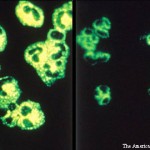New Clinics & Telling Symptoms
For patients with GCA, Ingeborg Sacksen, MD, FACP, clinical associate professor in the Division of Rheumatology at the University of Washington, described another advance in the form of a new fast-track clinic. The vasculitis can inflame the great vessels and dramatically reduce their blood carrying capacity—particularly the temporal and ophthalmic arteries—and cause relentless headaches and sudden, permanent vision loss in one eye, among its many potential symptoms.
In fact, Dr. Sacksen said, up to one-third of GCA patients will lose their vision and two-thirds will have distinct warning signs about one week prior to that loss. Quick treatment, then, is critical. “Time is vision,” she emphasized. Modeled after existing clinics in Europe, the university has set up its own fast-track clinic that includes a GCA hotline for physicians and a commitment to see patients within 24 hours for a medical evaluation.
Fortunately, ultrasound of the temporal and other arteries can reveal the halo sign, which is highly suggestive of GCA. “There’s nothing else in the world of ultrasound that looks like this,” Dr. Sacksen said. A positive ultrasound triggers immediate treatment with high-dose and sometimes intravenous steroids to prevent blindness. A negative ultrasound can still lead to treatment if doctors detect the presence of other worrisome signs, such as headaches and double vision. Once at-risk patients are treated with steroids, many can be managed with tocilizumab, the “new kid on the block,” she said.
Dr. Gardner said the University of Washington’s Division of Rheumatology has also started a once-a-month vasculitis clinic. He confirmed the university is trying to find a vasculitis-trained rheumatologist to head a dedicated vasculitis center and secure the necessary funding. “It’s in the early beginnings, and we’re looking to grow that,” he said.
In his talk, Dr. Gardner reviewed the main kinds of lung involvement in vasculitis, including bleeding, inflammation, fibrosis, nodules or cavities and blood vessel enlargement. Diagnosis of bleeding in the lungs or diffuse alveolar hemorrhage (DAH) can be made via a chest X-ray, more sensitive CT scan or bronchoscopy. Coughing up blood, he stressed, is a medical emergency that requires immediate attention.
Lung inflammation can present as lung infiltrates or a process that mimics pneumonia. “I’ve seen many patients who have been treated for pneumonia when they actually have lung vasculitis,” Dr. Gardner said. If the supposed pneumonia doesn’t improve, he said, doctors should seriously consider the possibility of vasculitis.
Pulmonary scar tissue, he added, is sometimes the first manifestation of vasculitis and may be marked by an increasing cough or shortness of breath. The key, Dr. Gardner emphasized, is to catch the scarring process early and treat it with medications like mycophenolate. “Once the lung has formed scar tissue, we don’t get that back,” he said.


